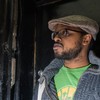A recent Black Lives Matter rally in New York City. (Photo by Erik McGregor/Pacific Press/LightRocket via Getty Images)
Advertisement
Advertisement
The Black Lives Matter event in Fort Greene, Brooklyn, attended by the author. Photo courtesy Stanley Lumax
Advertisement
